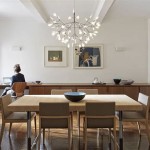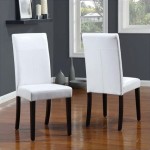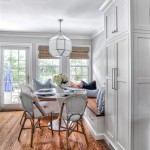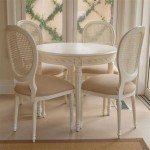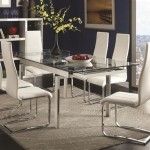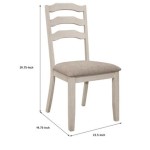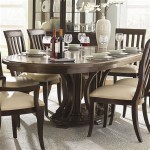Decorative Dining Room Wall Mirrors: Enhancing Ambiance and Space
Dining rooms serve as central hubs for social gatherings, family meals, and special occasions. The aesthetic appeal of a dining room significantly influences the dining experience. Decorative wall mirrors represent a valuable element in enhancing the ambiance, perceived space, and overall style of a dining area. A well-placed mirror can transform a drab space into an inviting and visually appealing environment.
Selecting the appropriate decorative mirror for a dining room requires careful consideration of several factors, including size, shape, style, and placement. These elements must integrate harmoniously with the existing decor to achieve the desired effect. The purpose of this article is to explore the various aspects of decorative dining room wall mirrors, providing insights into their benefits and strategies for effective incorporation into dining room design.
Maximizing Space and Light
One of the primary advantages of using mirrors in a dining room is their ability to create the illusion of greater space. This is particularly beneficial in smaller dining areas where maximizing the sense of openness is crucial. A large mirror strategically positioned on a wall can visually double the room's size, making it feel more expansive and less constricted.
The reflective properties of mirrors also contribute to improved lighting. Mirrors amplify natural light streaming in from windows, brightening the room and reducing the need for artificial illumination during daylight hours. This not only enhances the ambiance but also contributes to energy efficiency. When placed opposite or adjacent to a light source, such as a chandelier or sconce, a mirror can effectively distribute light throughout the room, creating a warmer and more welcoming atmosphere. The effect is amplified during evening gatherings, as the mirror reflects the glow from candles or other light fixtures, adding a touch of elegance and sophistication to the dining experience.
The size of the mirror plays a critical role in achieving these effects. For smaller dining rooms, a single large mirror spanning a significant portion of a wall can have the most dramatic impact on perceived space. In larger dining rooms, a series of smaller mirrors or a gallery-style arrangement can create a visually interesting feature wall while still contributing to the overall sense of spaciousness. The placement of the mirror is equally important. Mirrors placed at eye level are most effective at reflecting light and creating a sense of depth. Avoid placing mirrors in areas where they reflect clutter or unsightly views, as this can detract from the overall aesthetic.
Beyond simply reflecting light, mirrors can be used to highlight specific design elements within the room. For example, a mirror placed behind a decorative console table or buffet can reflect the objects displayed on the surface, effectively doubling their visual impact. Similarly, a mirror positioned to reflect a piece of artwork or a statement lighting fixture can draw attention to these features, enhancing their prominence and contributing to the overall design narrative of the dining room.
Selecting the Right Style and Frame
The style of the mirror should complement the existing decor of the dining room. There are numerous styles available, ranging from traditional and ornate to modern and minimalist. Choosing a mirror that aligns with the room's overall aesthetic is crucial for creating a cohesive and harmonious design.
For traditional dining rooms, mirrors with ornate frames featuring intricate carvings, gilding, or antique finishes can add a touch of elegance and sophistication. Frames made from materials such as wood, metal, or resin can be chosen to match the existing furniture and architectural details. Consider mirrors with beveled edges or antique mirror glass for a more vintage or classic look. These types of mirrors often feature elaborate detailing and embellishments, making them a focal point in the room.
In contemporary dining rooms, minimalist mirrors with clean lines and simple frames are often the best choice. Frameless mirrors or mirrors with thin metal frames can create a sleek and modern look. Consider geometric shapes or abstract designs for a more avant-garde aesthetic. Neutral colors such as silver, black, or white are typically preferred for contemporary mirrors, as they blend seamlessly with the surrounding decor.
The shape of the mirror is another important consideration. Rectangular mirrors are a versatile choice that can be used in a variety of settings. They are particularly effective for creating the illusion of height or width, depending on their orientation. Oval or round mirrors can add a softer, more organic touch to the room. These shapes are often used to create a focal point above a buffet or console table. Square mirrors are a classic choice that can be used in a variety of arrangements, such as a grid or a gallery wall. The choice of shape should be guided by the overall design of the room and the desired effect.
The frame of the mirror is an integral part of its overall design. The material, color, and detailing of the frame can significantly impact the mirror's aesthetic appeal. Wood frames are a classic choice that can be stained or painted to match the existing furniture. Metal frames can add a touch of industrial chic or modern elegance. Resin frames are a durable and affordable option that can be molded into a variety of shapes and styles. The color of the frame should complement the other colors in the room. Consider using a contrasting color to create a focal point or a similar color to blend seamlessly with the surrounding decor.
Strategic Placement for Optimal Impact
The placement of a decorative mirror is paramount to achieving its intended effect. Careful consideration must be given to what the mirror will reflect and how it will interact with the existing lighting and furniture in the room. A well-placed mirror can enhance the room's aesthetic appeal and create a more inviting atmosphere. Conversely, a poorly placed mirror can detract from the overall design and create an undesirable effect.
One common strategy is to position a mirror opposite a window to maximize the amount of natural light reflected into the room. This is particularly effective in dining rooms that lack direct sunlight or have limited window space. The mirror will act as a secondary light source, brightening the room and creating a more cheerful ambiance. When placing a mirror opposite a window, consider the view outside. A mirror that reflects a pleasant landscape or garden will enhance the room's aesthetic appeal, while a mirror that reflects an unsightly view may detract from it.
Another effective placement strategy is to position a mirror behind a dining table or buffet. This can create a focal point and add depth to the room. When placing a mirror behind a dining table, consider the height of the mirror. It should be positioned at a height that allows guests to see themselves comfortably without being overly self-conscious. A mirror that is too high or too low can be distracting and uncomfortable.
Mirrors can also be used to highlight specific design elements in the room. For example, a mirror placed behind a decorative console table or buffet can reflect the objects displayed on the surface, effectively doubling their visual impact. Similarly, a mirror positioned to reflect a piece of artwork or a statement lighting fixture can draw attention to these features, enhancing their prominence and contributing to the overall design narrative of the dining room.
Avoid placing mirrors in areas where they reflect clutter or unsightly views. This can detract from the overall aesthetic and create a sense of unease. Also, avoid placing mirrors directly opposite doorways, as this can create a jarring or disorienting effect. When placing mirrors in a dining room, consider the overall flow of the space and how the mirrors will interact with the other elements in the room.
Finally, consider the use of multiple mirrors to create a more dramatic effect. A gallery wall of mirrors can add a lot of visual interest to a dining room and create a sense of depth and dimension. When creating a gallery wall of mirrors, be sure to use a variety of shapes, sizes, and styles to create a visually interesting composition. Also, be sure to hang the mirrors at a consistent height and spacing to create a cohesive look.
By carefully considering the size, shape, style, and placement of decorative wall mirrors, it is possible to significantly enhance the ambiance, perceived space, and overall style of a dining room. The strategic use of mirrors can transform a drab space into an inviting and visually appealing environment, making it a more enjoyable place to gather and dine.
:strip_icc()/dining-room-mirror-ideas-1-ashley-montgomery-b90b98cab74443e9ab4f9d5e9f6ac2d2.jpeg?strip=all)
17 Dining Room Mirror Ideas That Ll Dress Up Your Walls

The Best Dining Room Mirror Ideas Zhush

Decorating With Mirrors In Some Stunning Ways World Inside S

Transform Your Dining Room With A Mirror Decoholic

Stunning Dining Room Accent Wall Idea

5 Dining Room Mirrors A Must Have For Every Home

3 Layered Decorative Wall Mirror With Metal Frame For Dining Living Room Costway

Small Dining Room Mirror Ideas Decordiva Org

Should I Need A Dining Room Mirror Ideas

21 Dining Room Wall Decor Ideas From Designers Havenly Interior Design Blog

